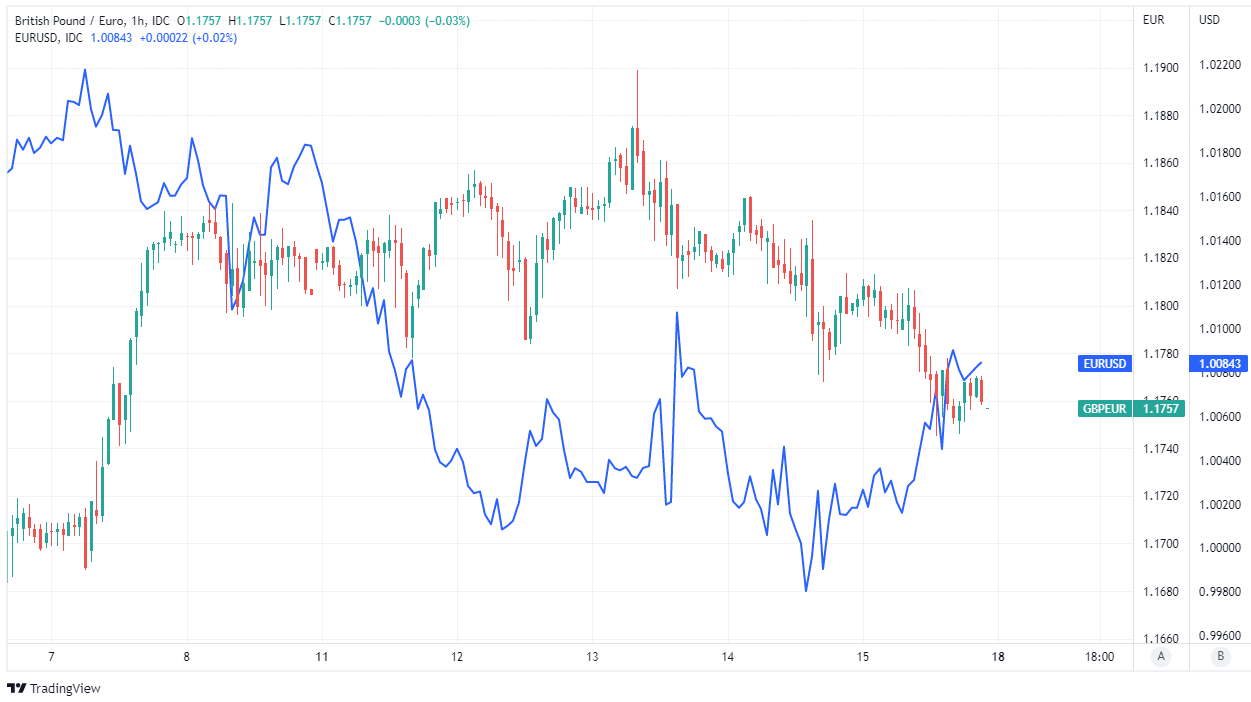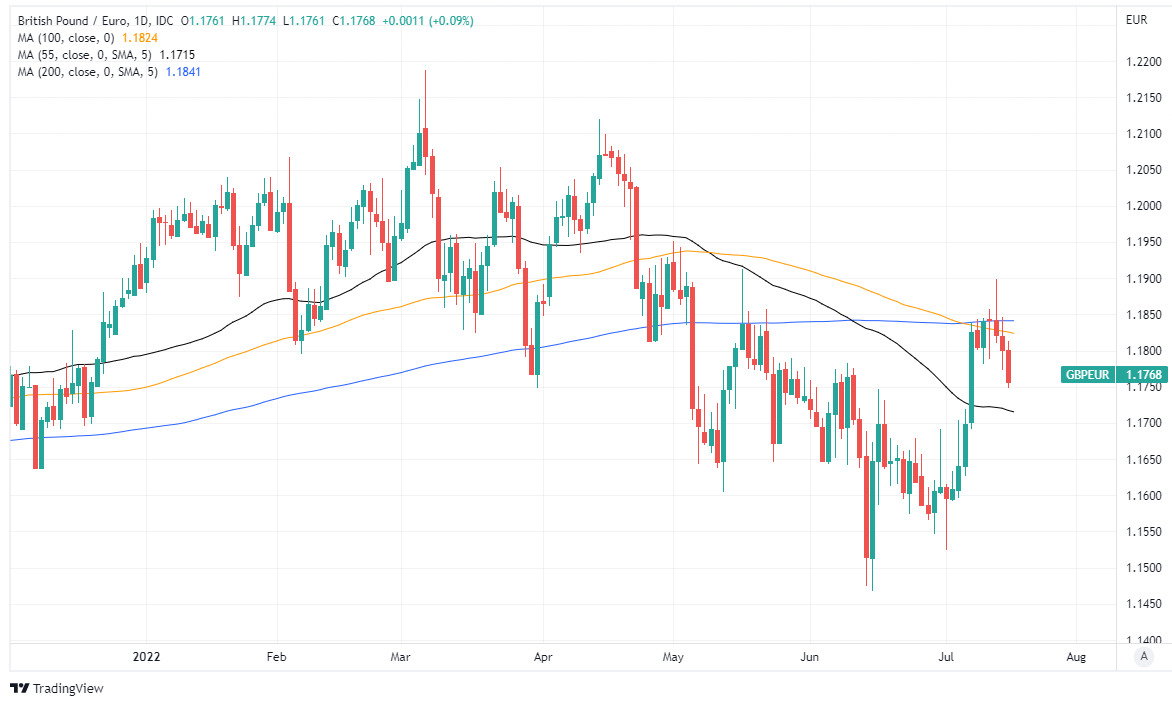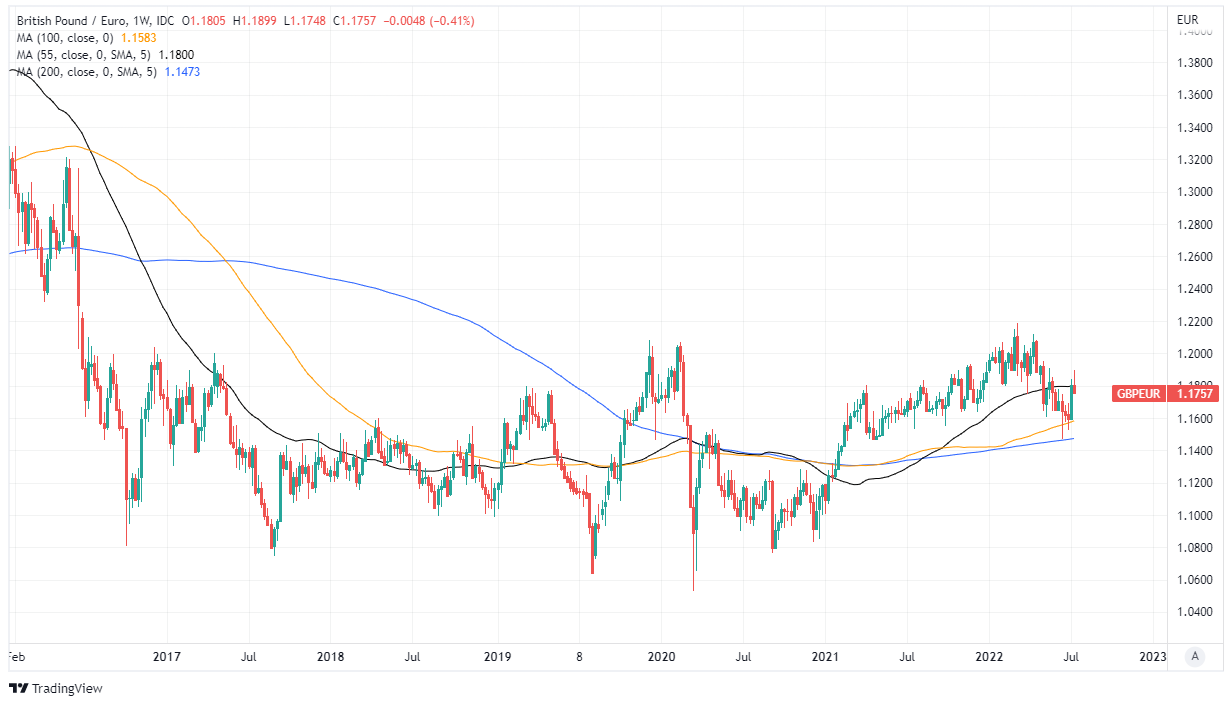GBP/EUR Week Ahead Forecast: Risk of Setback toward 1.17 on ECB’s Big Day
- Written by: James Skinner
-
- GBP/EUR struggling to hold above 1.1800
- Risking slippage & retest of 1.17 up ahead
- If ECB can allay fears about bond markets
- And Nordstream 1 gas flows resumes fully
- But scope for EUR disappointment is high
- UK data posing upside risks for GBP/EUR

Image © Adobe Images
The Pound to Euro exchange rate has retreated from near two month highs and could fall further toward 1.17 this week if all goes well for the European Central Bank (ECB) on Thursday but there’s also a flurry of UK economic data due out that could potentially incite Sterling into another climb above 1.18 beforehand.
Sterling climbed to its highest level against the Euro for more than two months last week as the single currency slipped below parity against the Dollar and the Pound benefited briefly from UK GDP data that came in much stronger than markets anticipated for the month of May.
The Pound came within inches of 1.19 before a rebound by the Euro pulled it lower over the latter half of last week, although Sterling will have multiple opportunities for further attempts at gaining a toehold above 1.18 before Thursday's risks from Europe become more pressing.
“We have so far argued that UK data does not support a faster pace of monetary tightening: inflation dynamics were beginning to fall into balance, expectations looked anchored, signs of persistence were still limited, and the labour market was cooling. But the latest batch of data challenges this view,” says Fabrice Mongtagne, chief UK economist at Barclays.
“GDP was higher than expected in May and previous months were revised higher as well, meanwhile gas futures have doubled since the beginning of July. Next week's major data releases (inflation, labour market, retail sales PMIs) will tell us whether we are past the peak or in the eye of the storm and will inform whether the MPC will deliver 25bp or 50bp in August,” Mongtagne adds.
 Above: Pound to Euro rate shown at hourly intervals with EUR/USD. Click image for closer inspection.
Above: Pound to Euro rate shown at hourly intervals with EUR/USD. Click image for closer inspection.
Thursday’s ECB decision and concurrent developments in the natural gas market will be key determinants of the Sterling-Euro outlook but before then UK employment figures for the month of May are due out on Tuesday and inflation data for June is set to be released on Wednesday.
Both sets of figures will be important for revealing the extent to which “second round” effects of energy price increases are reverberating through the economy hence why they will also help to decide the extent to which the Bank of England (BoE) lifts Bank Rate in August.
“Another upside inflation surprise in June would be an unwelcome development and would reinforce market expectations for the BoE to deliver a larger rate hike at the August MPC meeting,” says Lee Hardman, a currency analyst at MUFG.
Consensus suggests Tuesday’s annual wage growth number (excluding bonuses) is likely to have edged higher from 4.2% to 4.3%, and that Wednesday is likely to see the UK's inflation rate climbing from 9.1% to 9.3% for last month.
But it’s the core inflation number overlooking changes in food and energy prices that will matter most for the BoE, given that “second round” effects of rising commodity costs are what would lead the bank to lift interest rates further or faster than it has done so far.
 Above: Pound to Euro rate at daily intervals with 55, 100 and 200-day moving-averages. Click image for closer inspection.
Above: Pound to Euro rate at daily intervals with 55, 100 and 200-day moving-averages. Click image for closer inspection.
“We think that CPI inflation leapt to 9.4% in June, from 9.1% in May, exceeding the MPC’s 9.1% forecast. But the upside surprise will be due to a massive rise in motor fuel prices, and another increase in food inflation,” says Samuel Tombs, chief UK economist at Pantheon Macroeconomics, who tips the BoE as likely to opt for a 0.25% increase in Bank Rate to 1.5% next month.
A contagious spread of energy, food and tradable goods inflation was flagged by Governor Andrew Bailey and Chief Economist Huw Pill just last week as something that would likely trigger a faster and more aggressive, or simply more forceful, interest rate response from the BoE.
That makes Tuesday and Wednesday’s figures - as well as Friday’s retail sales data and PMI surveys - potential lifelines for a Pound that would be at risk of coming under pressure from the Euro if Thursday's developments in mainland Europe work in favour of the single currency.
These include a landmark ECB interest rate decision and the scheduled resumption of Russian natural gas flows through the Nordstream 1 pipeline, which connects Russia with Germany and other European economies but has been shut down for maintenance since July 11.
“Gas rationing, owing to interrupted Russia imports implies 1970s-style stagflation in Europe. It could trigger several quarters of European recession and we estimate a peak impact on GDP around 2.5pp below our baseline forecast,” says Camille de Courcel, head of G10 rates strategy at BNP Paribas.
 Above: Pound to Euro rate shown at weekly intervals with selected moving-averages. Click image for closer inspection.
Above: Pound to Euro rate shown at weekly intervals with selected moving-averages. Click image for closer inspection.
“We would expect the ECB to hike by 100bp this year (vs. 150bp in our central case). With the market pricing in an ECB policy rate of 1.25% by May 2023 and no rate cuts, risk remains tilted to the downside for the EUR front end, in our view,” de Courcel and colleagues said on Friday.
The Pound has benefited this month from market concerns about a possible permanent halt of Russian gas supplies after Nordstream 1 first went offline, suggesting there is a risk of setback for Sterling this Thursday if gas flows resume and return toward normal levels.
Such a setback would potentially be compounded for Sterling if the ECB manages to allay investor concerns about what could become of fragile Southern European bond markets as raises its interest rates from subzero levels later in the second half of the year, concerns that have hampered the Euro since June's policy decision.
“It’s still tough to envision a hawkish ECB surprise next week being sufficient to provide material EUR support,” says Paul Robson, head of G10 FX strategy EMEA at Natwest Markets, who tips GBP/EUR for another attempt at rising above its 200-day moving-average at 1.1841 this week.
“According to Bloomberg, market economists have started to revise down Euro area ’23 growth forecasts more sharply. This has come at the same time as the EUR has weakened against both GBP and USD,” Robson also said on Friday.











